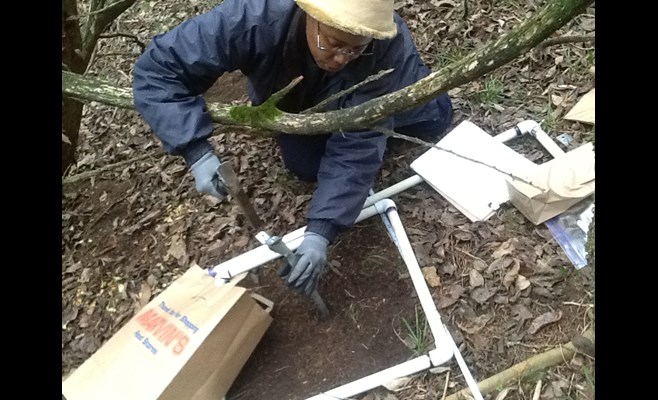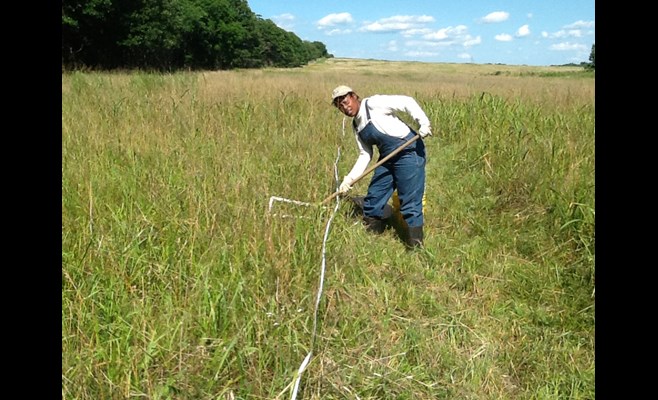Environmental Dynamics Graduate Student Studies Carbon Storage at Civil War Battlefield
FAYETTEVILLE, Ark. – Dorine Bower, a doctoral student in the Environmental Dynamics program at the University of Arkansas is compiling data that will help officials at Pea Ridge National Military Park make decisions about the preservation of the Civil War battlefield.
Bower is studying the biological way that nature captures and utilizes carbon in our atmosphere through plants, specifically at four sites at the military park in Northwest Arkansas. She is examining the different biological components in the grasslands and forests in the 4,300-acre park, to see which of them store the most carbon.
“The biological storage of carbon helps to mitigate the deleterious effects of the increasing concentration levels of greenhouse gases in our atmosphere,” Bower said. “With the information from my research, we will be able to quantify where the most carbon can be found in the park – among the trees, grasses, coarse woody debris, fallen leaves, twigs or soil, even down to the nut. This will aid the decision-makers at the park as they manage the park and its natural resources.”
Steve Stephenson, a research professor of biological sciences and Bower’s dissertation adviser, said, “Until her research project, there was no quantitative data on the total amount of carbon stored in any of the different types of vegetation in Northwest Arkansas. One other important aspect of her project is that she is looking at how the vegetation and thus the amount of carbon being stored have changed since the 1940s.
“This is important because we simply need to have a better handle on how the earth ecosystem ‘works’ and what we need to do to keep it working or make it work better,” Stephenson said. “It isn't too different from the cars we drive, just on a much larger scale.”
Bower took a non-traditional route to her graduate studies. She grew up in Washington, D.C., and went away to Trinity Bible College in Dunedin, Florida – only to drop out after she fell in love with a classmate and got married.
“I said to myself, ‘If I ever got a chance to go back to school, I would be ready,’” she recalls. “When I finally got the chance to go back to school 20 years later with my daughter, I jumped at the chance.”
She enrolled at Florida Atlantic University in Boca Raton, where she earned a bachelor’s degree in electrical engineering. She graduated three months after her daughter graduated from law school.
She developed an interest in solar energy at Florida Atlantic. After she and her husband relocated to Northwest Arkansas, Bower enrolled in the microelectronics-photonics graduate program at the U of A. The program, better known by its nickname “microEP,” requires its students participate in cross-departmental research, take classes focused on applications from multiple engineering and science departments, and develop workplace productivity skills in a simulated industrial environment.
Bower earned a master’s degree in microelectronics-photonics in 2008 – she defended her master’s thesis on Earth Day that year – and entered the Environmental Dynamics graduate program in 2009. Environmental dynamics is the study of complex interactions between natural systems and human activity. The program stresses interdisciplinary analyses of geophysical, biological, geochemical and sociocultural interactions related to environmental change.
“The study of carbon storage has been a natural progression from my research with solar cells,” Bower said. “I am now studying the original solar cells – plants and how they process the carbon from our atmosphere. I’m really interested in renewable energy and the health of the planet.”
Contacts
Chris Branam, research communications writer/editor
University Relations
479-575-4737,
cwbranam@uark.edu




